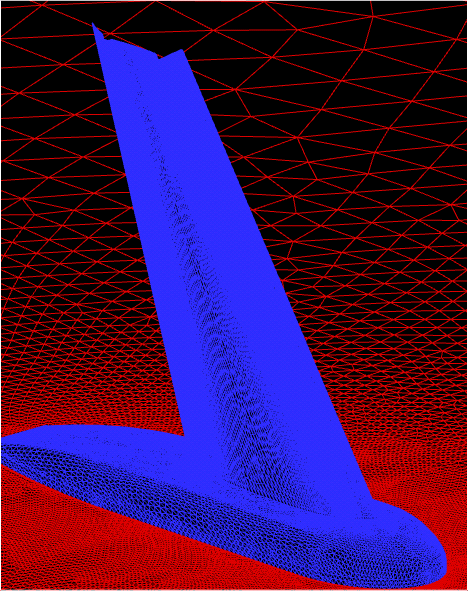
FREQUENTLY ASKED QUESTIONS
1st
AIAA CFD High Lift Prediction Workshop
Q1: Are there references available on the
Trap Wing?
A1: Some
known relevant references are listed in the following document:
HighLiftWorkshopPublications-07-09 (pdf file).
Q2: If I create my own grid(s) and upload them to the
HiLiftPW Committee, what will happen to them?
A2: Note that
HiLiftPW participants are required to run on one of the provided grids if possible.
However, if you create and run on your own
grid(s), then you must upload them to the HiLiftPW Committee. In the spirit of scientific openness,
this is to insure that possible grid-related reasons for different results can be uncovered.
Uploaded grids will be made openly available to
other HiLiftPW participants as well as to independent researchers conducting post-workshop analysis.
Q3: If I want to run
different grid families, different CFD codes, or different turbulence models, how will
they be treated and what do I do?
A3:
Each set of runs with a particular set of grids (C, M, F, XF of a given family),
particular code, and particular turbulence model is treated
as one "submission," and results therefrom should be submitted with one set of data forms
(see: Data Submittal Forms page).
If you make additional runs using a different grid family, a different code
or methodology, different turbulence model, etc., then you should
submit a new set of data forms for each additional set of runs.
Q4: When are abstracts
due, and what has to be included in it?
A4:
Abstracts are due April 2, 2010.
You must send in an abstract if you
plan to submit data and present results at
the workshop. The abstract should be no more than 1 page long,
and should contain at least the following information:
- name(s)
- affiliation(s)
- corresponding author contact information
(mailing address, phone number, and
e-mail address)
- brief description of solver code(s)
- name of supplied
grid(s) being used and/or brief description of
other grid(s) being used
- whether the optional case 3 is being computed
Please e-mail to:
hiliftpw@gmail.com.
Q5:
There seem to be differences between the Configuration 1 flap setting
given on this website and the Configuration 1 from an earlier website
(http://db-www.larc.nasa.gov/trapwing/). Can you explain the difference?
A5:
There are some subtle differences between the Config #1 geometry provided for
HiLiftPW-1 and that associated with the previous NASA website. The official
geometry for HiLiftPW-1 is the very latest "as-built" geometry that had all
slat and flap gap and overlaps re-measured after the 2002/2003 NASA LaRC test
campaign. The geometry available from the previous NASA website reflects the
"as-designed" surfaces available for the 1998 test entry. For an unknown reason
at this time, the measured flap overlap for the 1998 entry was 0.0050
(dimensional overlap/chord), but the flap overlap that was re-measured after
the 2002/2003 test was 0.0028. And there was also variation in the overlap
across the span. After much discussion, the planning committee decided that
the 2002/2003 measurements best reflected the actual geometry run in the 14x22
tunnel.
For Config #8, no measurement of the actual "as-built" geometry was ever
undertaken, so the geometry currently on the HiLiftPW-1 website is essentially
the same as what was on the previous NASA website.
The committee feels that HiLiftPW-1 is focused more on CFD code-to-code comparisons
than on direct CFD comparison with experimental data. As such, differences in
absolute geometry are not as critical.
Q6:
If I make my own grids, how fine should they be?
A6:
The Committee decided not to publish any specific grid point targets, because
the grid density necessary to adequately resolve
high lift flowfields is one of the things we would like to learn from this workshop.
However, there are guidelines. See the Gridding Guidelines document posted on the
Grids page.
Q7:
Are there ready-made grids available for me to use?
A7:
Yes. See the
Grids page,
and click on the link to download grids. It is anticipated that more grids will continue
to be added over time, so visit this page often!
(Note that the grids available for download may or may not be appropriate for your
solver, and may or may not be of sufficient density and quality to yield accurate
results. You must judge for yourself.
The grids were created by independent groups, with various degrees of adherence to
Gridding Guidelines.
Grid density and quality
are two of the requirements being explored for this workshop.)
Q8:
Is there anything of particular interest or anything special that I should look for in
my trap wing solutions?
A8:
In addition to the basic force, moment, and pressure data file preparation required for
workshop participation, researchers are also asked (as much as possible) to focus on
qualitative and quantitative post-processing of Trap Wing flow solutions for
enhanced technical understanding of particular phenomena, and report these at
the Workshop.
See
Postprocessing Guide (pdf file).
Q9:
What do I need to do to attend the workshop?
A9:
To attend the workshop, both participants and non-participants must register for HiLiftPW-1 with AIAA: see
HILIFTPW-1 Registration (AIAA).
AIAA also gives details regarding travel and accomodations, visas, etc.
Note that registering for the Fluids, Applied Aero, Thermophysics, Plasma, Measurement, or
Flow Control conference alone does not give you access to HiLiftPW-1 (and vice versa). You must
specifically register for HiLiftPW-1, and pay its additional registration fee.
If you are a participant, you must submit an abstract and data submittal forms by
the deadlines listed on the
High Lift Prediction Workshop Home Page, and you must
prepare slides for an oral presentation to be given at the workshop (there is no written
paper).
Q10:
Should the metric standoff be included in the force and moment calculations?
A10:
Yes. The standoff part (see
cruisediagram-09June09.pdf)
is grouped as part of the body component.
Return to: High Lift Prediction Workshop Home Page
Page Curator and NASA Official Responsible for Content
Li Wang
Last Updated
June 10, 2011
Privacy Act Statement
Accessibility Statement

